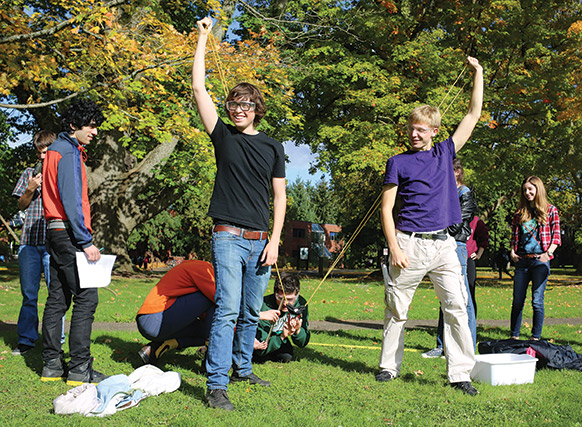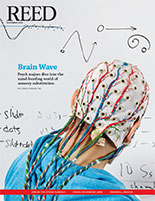
IRIS login | Reed College home Volume 93, No. 4: December 2014
Letter from the editor
Cracking Eggs

Photo by Tom Humphrey
By Chris Lydgate ’90
Making my way to the library the other day, I came upon an intriguing spectacle: a dozen students from physics 101 firing eggs across the Great Lawn with a makeshift slingshot.
The students were applying the principle of conservation of energy to a devilish problem: determining the minimum angle of trajectory required to be sure that an egg will actually smash when it hits the ground.
At first glance, the experimental apparatus—some sturdy forearms and a length of surgical tubing—seemed rather primitive. But in physics, as elsewhere, appearances are deceiving. It turns out that this investigation requires just four measurements: the angle at which the egg is flung, the distance between launch and landing, the mass of the projectile, and the average length of the grass. Armed with these numbers, the students can calculate the force with which the egg strikes the sod.
The first two attempts yielded no rupture, much to the students’ dismay (recent rains, they theorized, must have softened the ground). On the third try, however—at an angle of 52 degrees and a horizontal displacement of 59 meters—the egg was finally vanquished, to huzzahs from the assembled onlookers.
Trooping back to the lab, the students then embarked on the next stage of the experiment—piling iron weights atop an egg nestled in foam padding to determine the amount of force necessary to break it (a cruel science, physics). Finally, they compared this vector with the one derived from Newton’s second law of motion.
Fun? Yes. Frivolous? Definitely not. The experiment demonstrates the conservation of energy, spurs debate on the best way to understand collision, and poses questions about structural integrity. Talk to a Reed physics major about this subject for any length of time, and you’re liable to wind up discussing bicycle helmets, cannonfire, the whether the Coriolis Effect played a role in the Battle of the Falkland Islands, when British shells kept landing astern of their German targets.
I’ve always admired Reed’s approach to physics, epitomized by Prof. Nicholas Wheeler ’55 (see profile in this issue). “My ambition was to get to the bottom of things,” he says. “At the time I still supposed that was possible, but the bottom was far deeper than I imagined.”

LATEST COMMENTS
steve-jobs-1976 I knew Steve Jobs when he was on the second floor of Quincy. (Fall...
Utnapishtim - 2 weeks ago
Prof. Mason Drukman [political science 1964–70] This is gold, pure gold. God bless, Prof. Drukman.
puredog - 1 month ago
virginia-davis-1965 Such a good friend & compatriot in the day of Satyricon...
czarchasm - 4 months ago
John Peara Baba 1990 John died of a broken heart from losing his mom and then his...
kodachrome - 7 months ago
Carol Sawyer 1962 Who wrote this obit? I'm writing something about Carol Sawyer...
MsLaurie Pepper - 8 months ago
William W. Wissman MAT 1969 ...and THREE sisters. Sabra, the oldest, Mary, the middle, and...
riclf - 10 months ago